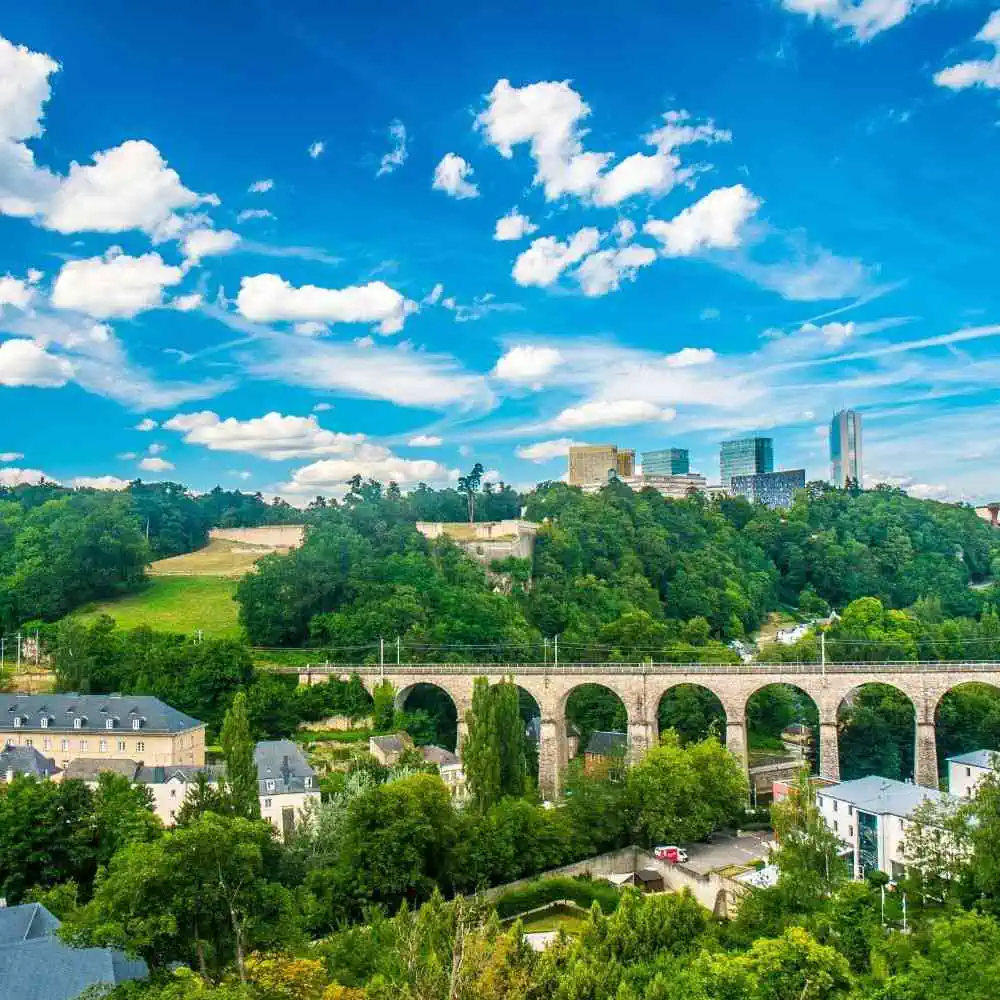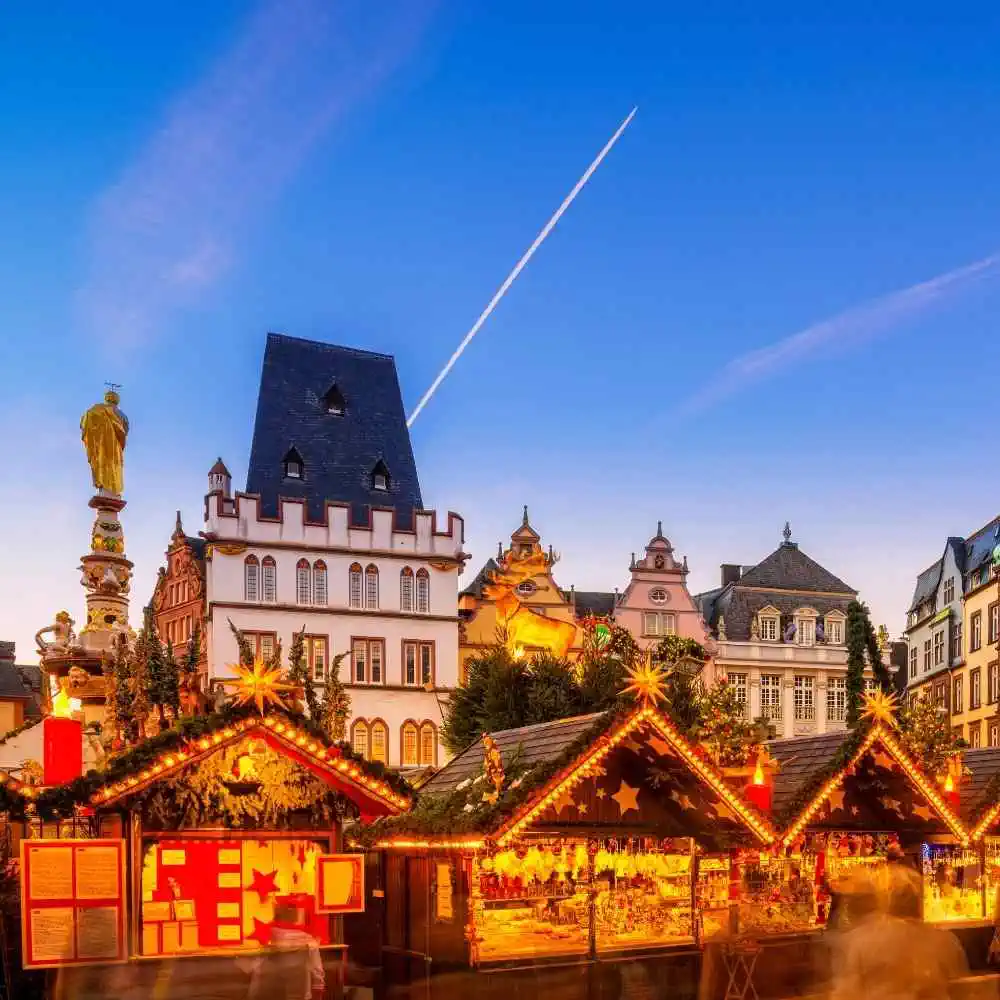Wyruszysz z Trier Hbf, położonego w samym centrum miasta Trier, i będziesz cieszyć się pięknymi widokami podczas podróży, aż dojdziesz do Luksemburg, które również znajduje się w sercu Luxembourg.
Pociągi z Trier do Luxembourgod € 10.00
Pociągi z Trier do Luxembourg
Podróżowanie pociągiem: Trier - Luxembourg

Szczegóły podróży
How long does the train from Trier to Luxembourg take?
The train journey from Trier to Luxembourg typically takes approximately 50 minutes to 1 hour, depending on the service chosen.
What is the fastest journey from Trier to Luxembourg by train?
The fastest train journey from Trier to Luxembourg can be as quick as 47 minutes, provided there are no delays and the connection is direct.
How much does the train cost from Trier to Luxembourg?
A one-way train ticket from Trier to Luxembourg can vary, but prices start from approximately €19 for a second-class ticket when booked in advance.
How much does the Trier to Luxembourg?
Yes, there are direct train services available from Trier to Luxembourg, making the journey more convenient for travelers.
What is the distance from Trier to Luxembourg by train?
The distance from Trier to Luxembourg by train is approximately 50 Km, making it a relatively short and scenic route.
Which are the cities that the train stops from Trier to Luxembourg?
The train from Trier to Luxembourg may stop at various cities along the route, including Igel, Wasserbillig, and Mertert, depending on the service.
Trier: Miejsca do zobaczenia
Trier is one of Germany's oldest and most historical cities, and a visit is guaranteed to be one of the most interesting and enriching experiences you can have in the country. From ancient Roman ruins to stunning cathedrals, Trier has countless tourist attractions to offer. Here is a list of must-visit sites in Trier, along with helpful tips on how to get the most out of each visit.
Porta Nigra: This ancient Roman gate is one of the most iconic landmarks in Trier. Dating back to the 2nd century AD, it is one of the best-preserved Roman city gates in the world. Located in the city centre, no visit to Trier is complete without seeing this impressive structure. Entrance costs €3 and is open from 9 am to 6 pm daily.
Trier Cathedral: This towering structure overlooks the city and is the oldest Gothic Cathedral in Germany. Stunningly located on the banks of the Moselle River, this impressive church is a must-see. The Trier Cathedral is open from 7.30 am to 5 pm daily, and entrance is free.
Amphitheatre: Trier is also home to an ancient Roman amphitheatre, built around 100 AD, which could once seat up to 20,000 spectators. The amphitheatre is open from 9 am to 5 pm daily and entrance costs €4.
Karl Marx House: This museum is dedicated to the life of Karl Marx, one of the most influential philosophers and political figures of all time. The museum is located in the area of the city where Marx was born in 1818 and provides an interesting insight into his life and the history of Trier. The museum is open from 10 am to 6 pm daily, and entrance costs €3.50.
Igel Column: This impressive 12th-century column is all that remains of an ancient Roman temple. Located in the city centre, the column is an ideal place to take a break and admire the view of the city. The Igel Column is open from 10 am to 6 pm daily and entrance is free.
Barfüßerkirche: This 11th-century Romanesque church is one of the most historic churches in Trier. Located near the Porta Nigra, the church is home to a variety of incredible sculptures and artwork. The Barfüßerkirche is open from 10 am to 5 pm daily and entrance is free.
Trier Gastronomy: Eating is an important part of any trip to Trier, and there are a variety of local delicacies to try. From its famous spätzle and sauerbraten to its delicious Moselle wines, there's something for every taste. For the best local food, head to the Marktplatz, where you'll find a variety of restaurants and cafes.
Trier is an exciting city that is sure to provide an unforgettable experience. Whether you're drawn in by the ancient Roman ruins, the stunning cathedrals, or the delicious local cuisine, this city has something for everyone. With the help of this guide, your visit to Trier is guaranteed to be an incredible and enriching experience.

Luxembourg: Miejsca do zobaczenia
Cheese, castles, and cobblestone streets - a visit to Luxembourg is a trip through Europe’s most delightful destinations. Whether you’re keen to explore Luxembourg’s historical sites or sample the country’s delicious local cuisine, there’s something for everyone. With its central location in the heart of western Europe, Luxembourg is the ideal destination for travelers looking for a unique, immersive experience. Here’s a list of the seven must-visit historical and architectural sites and what to eat when in Luxembourg.
Grand Ducal Palace: This is the official palace of the Grand Duke of Luxembourg and remains a key cultural hub in the city. Visiting the palace is free, and opening hours are 8am-4pm. Inside you’ll get to experience luxurious, gothic-style interiors, as well as a breathtaking view of the Alzette and Petrusse valleys.
Casemates of Luxembourg: This complex of underground tunnels was built in the 17th century and served as a fortress during the Napoleonic wars. It is located in the UNESCO-listed city centre, and the entrance fee is €6.50. Visitors will find tunnels, bunkers, and some stunning views of the city from the top of the fortress walls.
Bock Casemates: Also located in the city centre, the Bock Casemates are a network of tunnels built in the 10th century. It is said that this incredible fortress once housed up to 30,000 people, and is the most visited tourist attraction in the country. Entrance fees are €7.40, and opening hours are 8am-7pm.
Notre-Dame Cathedral: This intricate Gothic-style cathedral is also part of the UNESCO World Heritage Site. It is the most well-known and well-preserved religious building in Luxembourg, and has been standing since 1613. Entrance is free, and a guided tour can be booked in advance for a €6 fee.
Pattiserie Levallois: Visiting Luxembourg is not complete without sampling some of the country’s delicious pastries. Pattiserie Levallois is a must-visit for anyone who’s looking to taste some of the best pastries in the city. From the traditional kugelhopfs to the decadent éclairs, there’s something for everyone here.
Alzette Valley: The Alzette Valley is a nature reserve located in the south of Luxembourg and is the perfect spot for a day trip. Here, visitors can take a leisurely stroll along the river, or take a tour of the many castles and monuments that line the valley. An entrance fee of €4 per person is required to access the park.
Luxembourg City History Museum: Located in the heart of the city, the museum provides an in-depth insight into the history and culture of Luxembourg. The museum has a range of interactive displays and exhibits, as well as a cafe. There is an entrance fee of €7 for adults, and it is open from 10am-6pm.
A trip to Luxembourg is guaranteed to be a memorable one. From the historical and architectural sites to the delicious local cuisine, there’s something for everyone in this charming European city. So go explore and experience all that Luxembourg has to offer.

Trier: Główne stacje kolejowe
Trier is the oldest city in Germany and its main train station is named after it. Trier Hauptbahnhof is located in the city center and is served by regional and international connections. There are also two other important stations in Trier: Trier West and Trier Mitte. From these stations, visitors can reach Luxembourg as well as other cities and attractions in Germany.
Trier Hauptbahnhof is located at Bahnhofsplatz 1, 54290 Trier, Germany. It is open 24/7 and provides a wide range of services, including baggage storage, shops and restaurants, access to local and regional transport, and other facilities. The contact telephone number is +49 800 150 70 75, and the customer service is available in English.
- Trier Hbf
Luxembourg: Główne stacje kolejowe
Luxembourg is a small country in Europe and its main train station is Luxembourg Central Station. This station is served by national operators and international companies. It connects Luxembourg with the main cities in the surrounding countries. Additionally, there are other important train stations in the city such as Pétange-Aubange, Esch-sur-Alzette and Differdange.
Luxembourg Central Station is located at Place de la Gare, L-1616 Luxembourg. The station is open 24-7 and there is a ticket office with detailed information about timetables and tickets. It also offers services such as toilets, a baggage storage room and free Wi-Fi access. You can contact the staff at +352 2489 2489.
- Luksemburg
Trier - Luxembourg: Jak uzyskać najlepsze oferty
Rezerwuj z wyprzedzeniem:
Tak jak w przypadku cen biletów lotniczych, ceny biletów kolejowych mają tendencję do wzrostu, gdy data odjazdu zbliża się. Rezerwacja tygodni lub nawet miesięcy z wyprzedzeniem może przynieść znaczne oszczędności.
Podróżuj poza godzinami szczytu:
Unikaj podróżowania w godzinach szczytu, takich jak poranki i wieczory w dni robocze. Wybierz południe, późny wieczór lub środek tygodnia, gdy popyt jest mniejszy.
Rozważ wolniejsze pociągi lub trasy pośrednie:
Pociągi ekspresowe lub szybkie mogą zaoszczędzić czas, ale często są droższe. Wybór regionalnych lub wolniejszych usług może zmniejszyć koszt biletu.
Szukaj specjalnych ofert i promocji:
Przewoźnicy kolejowi od czasu do czasu oferują promocje lub specjalne okazje, szczególnie poza sezonem szczytowym. Warto zapisać się na newslettery. Ponadto czasami dostępne są zniżki dla grup lub na bilety powrotne, więc rozważ te opcje, jeśli pasują do Twoich planów podróży.
Wszystko, co musisz wiedzieć
Potrzebujesz pomocy?
Gwarantowana bezpieczna płatność
Certyfikaty


